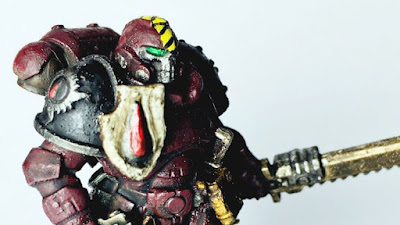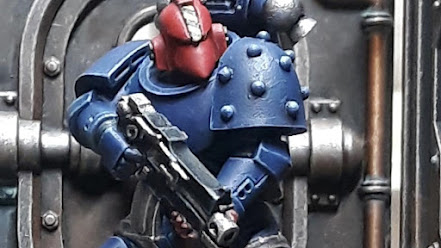Index Astartes: Vigilants
Designated Vigilants are to be marked out by a red armour panel with a yellow and black stripe. Primary and preferred location is helm – though given the cultural sensitivities of those Chapters that shall remain nameless, any plate that allows clear and immediate identification is deemed acceptable to the Senatorum Imperialis and Ordo alike.
Other than this identifier, members of the Ordo Militant are permitted to wear their Chapter colours unaltered. They may additionally be demarcated as their Inquisitorial handler deems fit and appropriate; and – where possible – palatable to the Astartes himself. As our learned fellows in the Adeptus Mechanicus might put it, why risk offending the machine spirits?
+ Extracted from Doctrinal brief: Order Militantis +
History of the Vigilants
The Ordo Astartes is a well-established group of Inquisitors whose concern is ensuring that treachery, both wholesale and at an individual level, is not allowed to worm its way into the twin hearts of the Emperor's Space Marines. As the Horus Heresy itself illustrated, the Astartes were far from immune from the very human frailties that leads warriors into rebellion – frailties that perforce include arrogance, secrecy and denial: weaknesses that are difficult, if not impossible for baseline humans to root out from the post-human demigods that form the Adeptus Astartes.
After a number of high-profile – though swiftly redacted – events in which Ordo Astartes agents, Inquisitors and forces under their command were terminated by Astartes on their homeworlds, the Ordo petitioned the High Lords of Terra for an Order Militant, citing their 'inalienable rites' granted in the wake of the Great Heresy. As it is recorded in the Vigilants' own records, that the Ordo might 'better performme their dutyes in warding Hysse relme of Foul Treacheries and Seditions enacted by the Chapterres Astartes.'
Under the auspices of both the Inquisitorial Representative to the High Lords and the Captain-General of the Adeptus Custodes – and with the patronage of Primarchs Rogal Dorn and Corvus Corax – the Vigilants were established as a 'Mentorring Legionne' during the Great Scouring. Far from the supervisory role this suggested, the Vigilants were very much watchmen – lurking in the shadows to come down heavily on any sedition or heresy detected by the Inquisition. This understandably led to great tensions between the Adeptus Astartes and the Inquisitorial orders; tensions that had to be weighed against the advantages of sending Chapter members to serve within the ranks of the Order Militant.
It was between the second and third foundings that the Order was at its apex; in the wake of the purging of the Wolf Brothers by the Ordo Astartes. As the centuries passed, what had been an experiment became rather more of an honour-posting in the eyes of many Space Marines, helping to de-esecalate tensions. Service with the Vigilants became a de facto route to officer rank in a number of Chapters, and the Astartes as a whole competed to send their best.
Ties to the long inward-looking Adeptus Custodes in the centuries that followed gradually expanded, and by the time of the War of the False Primarch, the Custodes came to use the Vigilants as intermediaries – a relationship which eventually led to the Vigilants being disbanded.
***
Vigilants during the War of the False Primarch
The capabilities of the enemy forces are – to put it bluntly – exceeding our own. Whatever the Abomination is, it and its forces have thus far outmatched every agent we've deployed. To that end, I have petitioned the Ordo Astartes to give me something that will tip the balance back in our favour.
[//Admiral Xiao Ti-Gung, Battlefleet Morqub+]
The Vigilants operated all over the galaxy – in essence, wherever the Inquisitors of the Ordo Astartes required them. They were typically drawn in detail; one or two notable warriors being sent for a tour. Some Chapters, however, sent larger groups. Combat squads were relatively common, and forces numbering fifteen or more from a single Chapter were not unheard of – though these were both rare and generally at the direct, short-term request of an Inquisitor for a particular task.
The appearance of a figure claiming to be one of the Emperor's twenty Gene-sons was cause enough to alert Inquisitorial forces across the Segmentum – many of whom were able to respond swiftly with small strikeforces that included Astartes elements of the Vigilants. That four Chapters had apparently heralded the 'Primarch' as having greater precedence to command of the Imperium than the Senatorum Imperialis (or High Lords of Terra, to use the Low Gothic) was a cause for rather more than alertness; and absolutely within the wheelhouse of the Ordo Militant tasked with ensuring discipline and loyalty within the Adeptus Astartes.
 |
| [//Pict-capture from Vigilant helm-cam; Choreopsis. Pictured individual of the Astartes Chapter Inheritors+] [//lars_j-d+] |
Always swift to react, the Inquisition were thus well-placed to deploy their Orders Militant within the Morqub Sector almost immediately. Thus began the so-called Shadow War, prosecuted by Lord Inquisitor Leong-Cassar against the Primarch's supporters, some decade prior to the official sanction of the High Lords' Extinction Armadas and the formation of the Pentarchy of Blood.
The Vigilants were front-and-centre of many of these early actions, performing intercessionary strikes, debilitating raids and assassinations on a number of worlds visited by agents of 'the Four'. These actions notably included the Battle of Choreopsis, which saw the Vigilants deploy in strength against the portion of the ill-starred Inheritors Chapter, already reeling from their losses against the Eldar of Dain-Mir and attempting to fall back to their homeworld, Hyperborea.
 |
| [//Astrographical Chart – Sector Morqub: Choreopsis system highlighted+] |
The world of Gurro VII saw the next substantial deployment of the Vigilants, with a force of seventy-eight – notably including two full squads of Flesh Eaters – supporting the Ordo Propter Stormtroopers in their pogrom against Partisan sympathisers.
 |
| [//Rafen, Chapter Astartes Serrated Blood; on secondment to the Odo Astartes during both the Choreopsis and Gurro campaigns +] [//andre_j_f+] |
 |
| [//Astrographical Chart – Sector Heliopolia: Gurro system highlighted+] |
These two deployments demonstrated both the strength of the Order Militant and their obvious drawbacks. When deployed in detail or at squad level alongside or overseen by Inquisitorial staff, Vigilants proved crucial in turning a number of critical situations in favour of the High Lords – a street-level of power that proved unmatchable by pro-Primarch Partisan forces until the establishment of the Marines Mendicant (the subject of a future article); believed by many in the Inquisition to be a direct counter to the Vigilants.
However, when deployed in strength, their influence was diluted. Despite being precociously well-equipped and with high individual standards of initiative, large numbers of Vigilants frequently failed to gel as larger fighting groups, with differing philosophies and strategic instincts slowing tactical reaction times – frequently fatal during inter-Astartes warfare. Inquisitorial staff, despite high levels of skill and enhancement, were unable to match the cohesive skill and application of warcraft of the opposing astartes' officer cadre.
 |
| [//Suspected Marines Mendicant; Inheritors Chapter+] |
Worst of all, however, was the reaction of the local Chapters to the large-scale deployment of these agents. Both primary deployments indirectly resulted in hardening of battle lines: the Battle of Choreopsis seeing In particular, the Vigilants' aggression and success against the Iron Guard were a cassus belli for the Master, and the proud Chapter were drawn into the war on the Primarch's side as a direct result of being attacked by the Vigilants.
It was as a result of the unforeseen consequences of these primary deployments that the Vigilants were withdrawn from such front-line service. In may ways their success worked against them. During the later stages of the war, the Vigilants were moved to a more clandestine role; which allowed them to operate in smaller numbers across a wider area. With more than two hundred Chapters in the Segmentum, most of which continued to send their best to serve in the Vigilants, the Order Militant remained an important rod in the High Lords' hands – albeit one that had a comparatively minor role to play. As the true numbers of turncoat Chapters became clear, the Senatorum Imperialis' made the fateful decision to restrict the intelligence granted to Astartes operatives, which minimised the ability of the Inquisition to deploy Vigilants, and re-emphasised the importance of the Pentarchy of Blood as their activity in the region increased.
During the height of the war, the Vigilants therefore played a small but not inconsequential role in supporting the Extinction Fleets of Terra. In the closing years, the Vigilants were crucial in tracking and terminating any survivors of the Partisan cause – particularly any surviving Astartes.
***
Markings and equipment
The primary identifier of the Vigilants were a single crimson plate of armour, marked with a yellow and black stripe. There were numerous variations on this; including diagonal, horizontal, and vertical stripes, along with chevrons and dags. Most Vigilants chose their helm for the markings, but as some heraldic schemes clashed with the use of the helm, or individual considerations were given to the machine spirits of the armour, other areas were sometimes substituted. These included pauldrons, shins and kneeplates.
 |
| [//james_p_t+] |
The Vigilants' iconography was directly inspired by the pre-Heresy-era Consul-Opsequiari corps, a long-disbanded group of enforcers. Their symbol (pictured above) was also occasionally used – particularly in cases where the individual's armour scheme made the typical identifier unclear.
***
Hugely well-equipped as a result of the patronage of the Inquisition, the Vigilants received priority equipment and specialist weaponry in order to best their peers. Much of the more esoteric and irreplaceable equipment that had become scarce during the desperate fighting of the Great Scouring and War of the Beast, such as conversion beamers, graviton weaponry and eradication rifles, were relatively commonplace for the force. In addition, esoteric and experimental equipment was often fielded, including displacer fields, targetting webs and jealously hoarded chrono-grenades.
 |
| [//Vigilant drawn from Chapter Astartes: Crimson Fists; pictured during one of hte numerous boarding actions enacted during the battle of Choreopsis+] [//james_p-t] |
In the early years of the war, Vigilants were granted great freedom in the manner in which they enacted their role, and while many chose to make full use of the High Lords' coffers, others preferred to rely on their own tried-and-tested weaponry; citing familiarity and ease of resupply. Bolt ammunition, for obvious reasons, was relatively plentiful in the battlefields in which the Astartes-hunting warriors fought.
***
[//Paradigm: Designate – Brother Olybrius +]
Brother Olybrius served for three years in the early parts of the War of the False Primarch, sustaining heavy injuries during the fighting in the Qos Terminal system. His status as Vigilant is marked by the yellow and black stripe on his helm. Members from Chapters whose heraldry already incorporated red-helmed Chapters varied between simply adopting the stripe (as here), to demarcating the stripe by altering their heraldry – or by leaving their helm as Chapter-standard, and bearing the Vigilant honorific on a separate element.
A member of the Codex-adherent Patriarchs of Olympus Chapter, Olybrius has replaced Codex squad markings with the Sigil of the High Lords: a double-headed aquila faced with an I, and surmounted with an enhaloed skull. This was frequently simplified to a simple downward-pointing triangle faced with an I, particularly amongst more pragmatic or puritan Chapters, such as the Battle Kings.
Note the presence of the Consul-Opsequiari corps marking on the tasset. Less frequently applied than the red helm with stripe, the symbol was also often utilised by the Inquisitorial handler assigned to the marine. Olybrius bore a custom-blessed boltgun; altered to incorporate a foregrip intended to assist with the deleterious effects of the experimental ammunition with which he was issued.
 |
| [//edd_r+] |
***




